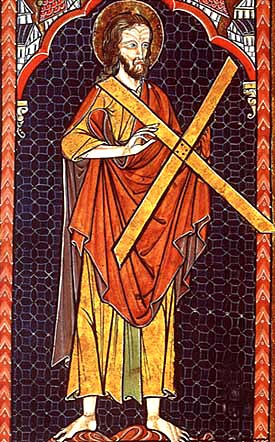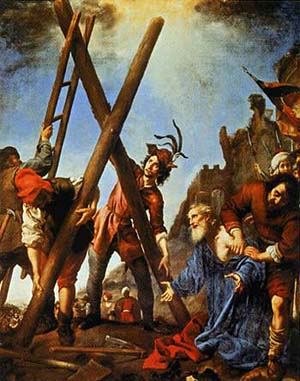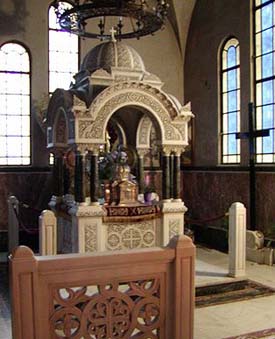 |
The Saint of the Day
St. Andrew – November 30
Prof. Plinio Corrêa de Oliveira
Biographical selection:
St. John the Baptist was on the banks of the Jordan with two disciples when he saw Our Lord passing. He pointed to Him and said: ‘Behold the Lamb of God.’ Andrew and the other disciple followed Our Lord and remained with Him that day.

St. Andrew with the saltire cross
(cross in the form of an X)
Illuminated manuscript, 1265-70 |
Andrew at once recognized Jesus as the Messiah, and hastened to introduce his brother Peter to Him (John 1:41). Andrew told Simon Peter: “We have found the Messiah.” And he brought Peter to Our Lord. When Christ beheld him, He said, “Thou art Simon, the son of Jonas: thou shall be called Cephas, that is, rock.” And so, St. Andrew had the glory of presenting to Our Lord St. Peter, upon whom the Church would be built.
Our Lord called Peter and Andrew to be Apostles one day when the two were fishing in the Sea of Galilee. He came up upon them casting a net into the sea and said to them, “Come with me, and I will make you fishers of men.” At once they left their nets and followed Him.
St. Andrew had a great love for the cross. As soon as he saw the cross on which he would be crucified, he saluted it with these words:
“O most beautiful cross that was glorified by carrying the body of Christ! Glorious cross, sweetly desired, ardently loved, always sought, and finally prepared for my heart that has so long awaited you. Take me, o cross! Embrace me. Release me from my life among men. Bring me quickly and diligently to the Master. Through you He will receive me, He, Who through you has saved me.”
He remained two days hanging on the cross, preaching to the people. These were his last words before he died:
“Lord, eternal King of glory, receive me hanging from the wood of this sweet cross. Thou who art my God, whom I have seen, do not permit them to loosen me from the cross. Do this for me, O Lord, for I know the virtue of Thy Holy Cross.”
Comments of Prof. Plinio:
It is impossible to have more beautiful prayers than these. Let me comment on the lines of the first prayer.

Two Jews (with caps) tying St. Andrew to the cross
Cistercian psalter, 13th century |
The first two sentences – “O most beautiful cross that was glorified by carrying the body of Christ! Glorious cross, sweetly desired, ardently loved, always sought, and finally prepared for my heart that has so long awaited you” – show that St. Andrew had known for a long time that he would be a martyr. He had meditated on it in relation to the Passion of Our Lord Jesus Christ. He entirely understood and loved the hour of his supreme suffering. He completely accepted the chalice God had prepared for him to drink.
The cross was a symbol of punishment and was reserved for criminals. But for St. Andrew, it was a “most beautiful” thing because it had been “glorified by carrying the body of Christ.”
Then, he added that he had “sweetly desired it.” With this, one understands that for years he had prepared himself to offer this disinterested holocaust: to be killed for the love of Our Lord, to allow himself be consumed and spent like the perfume that Mary Magdalene spilt to honor Our Lord. There was no practical goal in those acts of homage. They were sacrifices made for no other reason than to please God: to expend precious things in manifestation of love for Him. Even if his sacrifice would not produce a good for souls and a humiliation for the enemies of the Church, St. Andrew wanted do die a martyr to prove how much he loved Our Lord. This is why he said he had “sweetly desired” to be crucified. The words express the splendor of the soul of a martyr.

St. Andrew salutes the cross before being crucified
Carlo Doci, c. 1631 |
St. Andrew continued by saying that he had “ardently awaited” the cross. Today men flee far from any kind of suffering, any kind of fight against their own passions, any kind of renunciation. For them to live is to enjoy a good life. St. Andrew, however, ardently awaited his own cross because he understood that what counts in life is not the pleasure he has, but the sacrifice he makes. This is what gives meaning to life. Therefore, the truly supernatural man is a friend of the cross, as St. Louis Grignion de Monfort said so well.
St. Andrew not only accepted the crosses given him during his life, but he looked for them. This is clear when he said that he had “always sought” sacrifice. Then, in the hour of his martyrdom he had that marvelous reaction – he said that his “heart had long awaited” the crucifixion. Which one of us can say a thing like that? What a sublime courage St. Andrew had in saying these words, which, however, came to his lips naturally and with complete serenity because he had always lived in preparation for that.
Our Lord said that there is no greater friend than one who would give his life for the other. No one can give a greater proof of friendship with Our Lord than to desire the cross like St. Andrew did.
He continued: “Take me, o cross! Embrace me. Release me from my life among men. Bring me quickly and diligently to the Master. Through you He will receive me, He, Who through you has saved me.”
Can any soul be more prepared for the beatific vision than one who would make this prayer at the hour of his death?

In 1964 Paul VI ordered the head of St. Andrew to be handed over to the Schismatics of Patras, above |
He remained two days crucified. While he was on the cross he was teaching the people who watched him die. How priceless those teaching were! What cathedra could ever be more sublime to teach people from?
St. Andrew expired with the words of his second prayer. I believe that only the death of Our Lord was more beautiful than his.
Now, after contemplating the height of that sacrifice, you may consider the descent experienced today: the head of St. Andrew that for more than 500 years had been one of the most precious treasures of St. Peter’s Basilica, was given this year (1964) by Paul VI to the Schismatics of Greece. That is, handed over to the same Schismatics who hate the Petrine Primacy, deny Papal Infallibility and the Immaculate Conception of Our Lady, among many other Catholic doctrines.
When one reads about the life of St. Andrew, it is normal is to say that it is part of the past. But it is not true, the history of St. Andrew continues today in this distressing episode.
What should we ask St. Andrew on his feast day? I suggest asking him to avenge the glory of the Church and his glory. To not permit that his head remain in Schismatic hands for long. But above all, we should ask him to intercede so that this situation in the Church will not continue for a long time. The delivering of his head is a symbol of a thousand other things that are being given away.


Watch a video illustration of this Saint of the Day article
here

  | | Prof. Plinio Corrêa de Oliveira | |
The Saint of the Day features highlights from the lives of saints based on comments made by the late Prof. Plinio Corrêa de Oliveira. Following the example of St. John Bosco who used to make similar talks for the boys of his College, each evening it was Prof. Plinio’s custom to make a short commentary on the lives of the next day’s saint in a meeting for youth in order to encourage them in the practice of virtue and love for the Catholic Church. TIA thought that its readers could profit from these valuable commentaries.
The texts of both the biographical data and the comments come from personal notes taken by Atila S. Guimarães from 1964 to 1995. Given the fact that the source is a personal notebook, it is possible that at times the biographic notes transcribed here will not rigorously follow the original text read by Prof. Plinio. The commentaries have also been adapted and translated for TIA’s site.
|
Saint of the Day | Home | Books | CDs | Search | Contact Us | Donate

© 2002- Tradition in Action, Inc. All Rights Reserved
|
 |

|